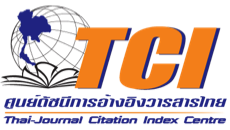KOH MAK: A SUSTAINABLE ECOTOURISM MODEL – POTENTIAL AND SUCCESS FACTORS
DOI:
https://doi.org/10.14456/tisr.2025.28Keywords:
Ecotourism, Koh Mak, Sustainability, Resource Management, Community ParticipationAbstract
This qualitative study investigates the potential and success factors contributing to ecotourism development in Koh Mak, Trat Province, Thailand. In-depth interviews were conducted with 25 key informants representing the public sector, private sector, academia, and the local community, selected using purposive sampling. The findings reveal Koh Mak's significant ecotourism potential, encompassing 1) inherent tourism appeal, 2) sustainable land management, 3) environmental education and awareness, and 4) community involvement. Furthermore, five key success factors were identified: 1) environmental management, 2) knowledge management, 3) low-carbon tourism practices, 4) enhanced tourist experience, and 5) multi-stakeholder participation. This research demonstrates that Koh Mak's ecotourism development extends beyond conservation, integrating systematic management, academic expertise, and collaborative efforts across various sectors. The findings provide a practical framework for sustainable ecotourism development in other destinations and serve as a valuable case study for regional and national tourism policy and strategic planning.
Downloads
References
กมลกนก เกียรติศักดิ์ชัย และ ชื่นชนก โควินท์. (2563). สมรรถนะของคนในชุมชนเพื่อการพัฒนาการท่องเที่ยวคาร์บอนต่ำในพื้นที่เกาะหมาก จังหวัดตราด. วารสารวิทยาลัยดุสิตธานี, 14(2), 16-30.
กรมการท่องเที่ยว. (2557). รายงานผลการจัดทำแนวทางการส่งเสริมและพัฒนาการท่องเที่ยวสีเขียว โครงการส่งเสริมและพัฒนาการท่องเที่ยวสีเขียว (Green Tourism). กรุงเทพฯ: กระทรวงการท่องเที่ยวและกีฬา.
กรมการท่องเที่ยว. (2565). แผนพัฒนาบริการท่องเที่ยว พ.ศ.2566-2570. สืบค้นจาก www.dot.go.th/storage/กองพัฒนาบริการ/แผนกองฯ/QtftdpYXKOCrXLds1f5xJfseslXaXcpgu3q3oDnM.pdf.
กระทรวงการท่องเที่ยวและกีฬา. (2560). ยุทธศาสตร์การส่งเสริมการท่องเที่ยวสีเขียว (Green Tourism). สืบค้นจาก http://tourismlibrary.tat.or.th/medias/T26666.pdf.
ชาคริต อ่องทุน และ นรินทร์ สังข์รักษา. (2562). การปฏิบัติที่เป็นเลิศในการจัดการท่องเที่ยวแบบคาร์บอนต่ำ: กรณีศึกษาชุมชนในภาคตะวันออกของไทย. วารสารวิทยาลัยดุสิตธานี, 13(2), 374-384.
ธนภูมิ ปองเสงี่ยม และ พยอม ธรรมบุตร. (2558). ศักยภาพทรัพยากรการท่องเที่ยวจังหวัดพระนครศรีอยุธยา. วารสารเทคโนโลยีภาคใต้, 8(2), 17-26.
นิคมศม อักษรประดิษฐ์ และ ธีรศักดิ์ อุ่นอารมย์เลิศ. (2560). กระบวนการบริหารจัดการการท่องเที่ยวแบบคาร์บอนต่ำ (Low Carbon Tourism) กรณีศึกษาพื้นที่เกาะหมาก จังหวัดตราด. วารสารศิลปากรศึกษาศาสตร์วิจัย, 9(2), 205-216.
นิคมศม อักษรประดิษฐ์ และ ธีรศักดิ์ อุ่นอารมย์เลิศ. (2560). กระบวนการบริหารจัดการการท่องเที่ยวแบบคาร์บอนต่ำ (Low Carbon Tourism) กรณีศึกษาพื้นที่เกาะหมาก จังหวัดตราด. วารสารศิลปากรศึกษาศาสตร์วิจัย, 9(2), 205-216.
บุตรี จารุจินดา, กมลพร กัลยาณมิตร, สถิตย์ นิยมญาติ และ ทัศนีย์ ลัขณาภิชนชัช. (2567). การพัฒนาการท่องเที่ยวภาคตะวันออกให้มีชื่อเสียงในระดับนานาชาติ. วารสารวิทยาลัยสงฆ์นครลำปาง, 13(2), 174-190.
ภัญนภัส พฤกษากิจ, ปิยาภรณ์ รัตโนภาส, จาตุรันต์ แช่มสุ่น และ ลัญจกร สัตย์สงวน. (2565). ความพึงพอใจของชุมชนบนเกาะหมาก เพื่อเป็นการยกระดับการพัฒนาแหล่งท่องเที่ยวต้นแบบ. วารสารการพัฒนาชุมชนและคุณภาพชีวิต, 10(2), 138-147.
องค์การบริหารการพัฒนาพื้นที่พิเศษเพื่อการท่องเที่ยวอย่างยั่งยืน (องค์การมหาชน). (2565). The Net Zero Promise. สืบค้นจาก www.dasta.or.th/uploads/file/202301/1674014283_f0f805cf87926b73d899.pdf.
องค์การบริหารการพัฒนาพื้นที่พิเศษเพื่อการท่องเที่ยวอย่างยั่งยืน (องค์การมหาชน). (2563). แนวทางการพัฒนาแหล่งท่องเที่ยวคาร์บอนต่ำในพื้นที่พิเศษ. กรุงเทพฯ: องค์การบริหารการพัฒนาพื้นที่พิเศษเพื่อการท่องเที่ยวอย่างยั่งยืน (องค์การมหาชน).
อนุวัฒน์ ชมภูปัญญา และ ธนัสถา โรจนตระกูล. (2565). การพัฒนาศักยภาพชุมชนแบบมีส่วนร่วมสู่ชุมชนท่องเที่ยวที่ยั่งยืน. วารสารการพัฒนาการเรียนรู้สมัยใหม่, 7(8), 414-430.
อารยา สุนทรวิภาต, ลักษมณ บุญมา, ธัชนันท์ สังวาลย์, กนกรัชต์ กาสาวพานิชย์ และ พัชรี ปรีเปรมโมทย์. (2565). ความพึงพอใจของนักท่องเที่ยว และแนวทางการยกระดับการพัฒนาแหล่งท่องเที่ยวอย่างยั่งยืน: เกาะหมาก จังหวัดตราด. วารสารสังคมศาสตร์ปัญญาพัฒน์, 4(4), 297-312.
อิสระพงษ์ พลธานี และ อุมาพร บุญเพชรแก้ว. (2560). องค์ประกอบศักยภาพของแหล่งท่องเที่ยวทางทะเลเกาะหมาก จังหวัดตราด. วารสารศิลปศาสตร์ปริทัศน์, 12(24), 95-102.
Boonratana, R. (2010). Community-Based Tourism in Thailand: The Need and Justification for an Operational Definition. Kasetsart Journal of Social Sciences, 31(2), 280-289.
Buckley, R. (2020). Nature tourism and mental health: parks, happiness, and causation. Journal of Sustainable Tourism, 28(9), 1409-1424.
Dodds, R., & Holmes, M. (2020). Is Blue Flag certification a means of destination competitiveness? A Canadian context. Ocean & Coastal Management, 192, 105192.
Gössling, S., Peeters, P., Ceron, J., Dubois, G., Patterson, T., & Richardson, R. (2005). The eco-efficiency of tourism. Ecological Economics, 54(4), 417-434.
Li, J., Hu, Y., & Li, S. (2022). Green tourism management in protected areas: A system-based approach. Journal of Sustainable Tourism, 30(5), 893-907.
Lopez, E., Perez, A., & Garcia, M. (2021). Stakeholder collaborations in eco-tourism: Key factors for community engagement. Journal of Ecotourism, 20(3), 245-259.
Stone, L., & Stone, T. (2011). Community-based tourism enterprises: challenges and prospects for community participation; Khama Rhino Sanctuary Trust, Botswana. Journal of Sustainable Tourism, 19(1), 97-114.
UN Tourism. (2021). Guidelines for integrated sustainable tourism development. Madrid: UN Tourism.

Downloads
Published
How to Cite
Issue
Section
License
Copyright (c) 2025 Authors

This work is licensed under a Creative Commons Attribution-NonCommercial-NoDerivatives 4.0 International License.









.png)


